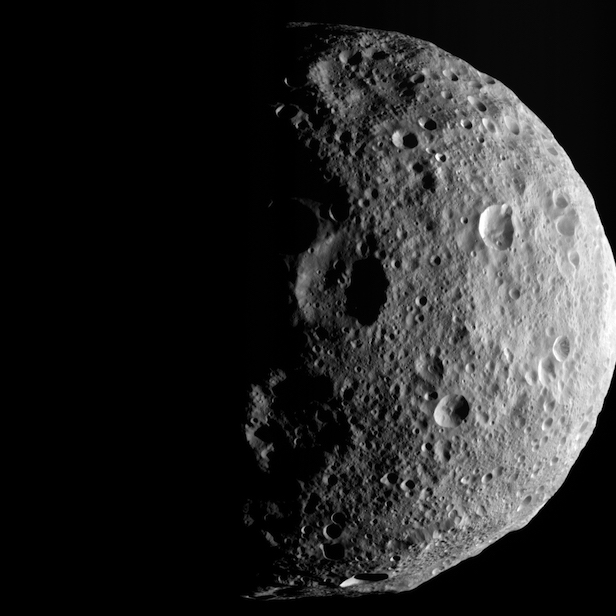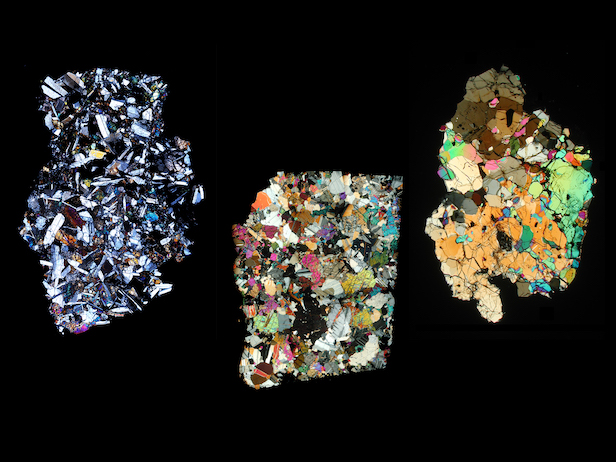Vesta was the victim of a ‘cosmic hit-and-run’
Astronomers have deduced from a meteorite that the second largest asteroid in the Asteroid Belt was part of a tremendous collision

The shadowy outlines of the terrain in Vesta’s northern region are visible in this image from NASA’s Dawn spacecraft. Image credit: NASA/JPL-Caltech/UCLA/MPS/DLR/IDA
The asteroid belt between Mars and Jupiter preserves the processes of planetary formation, frozen in time. Vesta, the second largest asteroid in this belt, provides an outstanding opportunity for scientists to investigate the origin and formation of planets. In particular, Vesta has kept its crust, mantle and metallic core, much like Earth. Careful mapping of Vesta by NASA’s Dawn mission showed that the crust at the south pole of Vesta is unusually thick.
In a paper just published in Nature Geoscience, Dr. Yi-Jen Lai of the Macquarie University Planetary Research Centre and Macquarie GeoAnalytical, in Australia, and her colleagues propose a new evolutionary history of Vesta involving a giant impact. This is based on precise age determinations of zircon crystals from mesosiderites, a type of enigmatic Vestan meteorite, and resolves past uncertainties about the evolution of Vesta.
Mesosiderites are a type of stony iron meteorite, consisting of crust and molten core materials from an asteroid/asteroids. These mysterious, rare meteorites give unique insights into the catastrophic break-up of differentiated (layered) asteroids, most likely Vesta.
Lead author, Dr. Makiko Haba of Tokyo Institute of Technology, Japan, says, “The major challenge is that fewer than 10 zircon grains favourable for age dating had been reported over a few decades. We developed a new method for finding zircons in mesosiderites and eventually prepared enough grains for this study.”

This image shows three slices of a class of meteorites that fell to Earth that NASA’s Dawn mission has confirmed as originating from the giant asteroid Vesta. Image credit: University of Tennessee
The team carried out high-precision dating using the uranium and lead isotopes of two dozen zircons in mesosiderites at the world’s leading geoscience research university, the ETH Zurich in Switzerland.
Macquarie’s Dr. Yi-Jen Lai says, “We discovered two significant dates: 4,558.5 and 4,525.39 million years ago, that relate to the initial crust formation and metal-silicate mixing caused by a cosmic hit-and-run collision.”
The researchers propose the new hit-and-run explanation for these two important new time points. In the new model, after Vesta had already differentiated into distinct crust, mantle and core layers, another asteroid about one-tenth Vesta’s size smashed into it, causing the large-scale disruption of the northern hemisphere. The debris from this impact, made up from all three of Vesta’s layers, got stuck onto the southern hemisphere of Vesta, explaining the unusually thick crust that NASA’s Dawn spacecraft detected at Vesta’s south pole. The new model also successfully explains Vesta’s distinctive shape and the lack of the mantle mineral olivine in the Vestan meteorites.
The team believes the concept can be applied to other planetary bodies to reconstruct their histories.
Keep up to date with the latest news in All About Space – available every month for just £4.99. Alternatively you can subscribe here for a fraction of the price!




